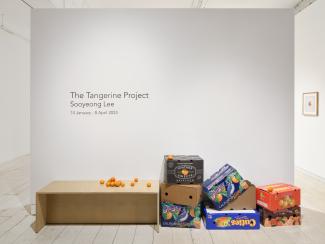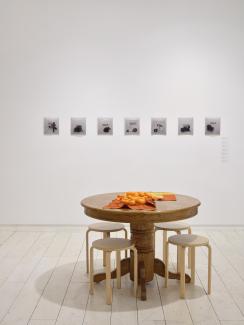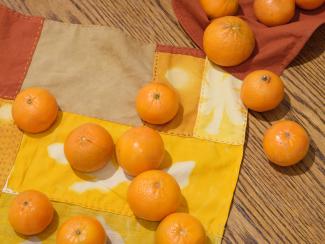The Tangerine Project presents work by Sooyeong Lee (Toronto, ON) which considers vulnerability, our shared anxieties, deterioration, the body, and care. The artist uses tangerines as a point of departure to consider surface and interior—not only of the physical body but of our psychological and social worlds. In this work, the artist gives thoughtful attention to carrying, documenting, and keeping decaying tangerines.
In Korean, one word is most commonly used for this family of small citrus known as tangerines.[1] Finding mostly mandarins here, Lee and I talked about the qualities to look for as we sourced the fruit for the exhibition—an ordinary, humble fruit that fits in the palm of your hand. “Growing up in Korea I learned that tangerines are meant for sharing. Naturally, I carried a few inside my pocket, so I could share one with a friend, sometimes an extra, in case I ran into a neighbour or another friend.”[2] Tangerines were offered without barriers by pharmacists or even strangers at a bus stop.
Here in Chinatown at Lunar New Year, they represent luck, prosperity, and a long life. This time of year I keep a bowl in my living room, reminded of their scattered peels on Christmas morning accumulating like wrapping paper. I carefully compost one to save the rest from the distinct mentholated effect of moulding citrus. This constant caretaking feels like a race to see if I can eat them before they are lost.
Within and outside of her art practice, Lee engages in meditative, domestic activities that root her to the present, focusing and soothing her mind and body—making tea, folding tea towels, peeling dried anchovies for Miyeokgook (birthday soup), or slowly eating a tangerine.
Today I’m Afraid… results from a past performance, Round and Round (2017), in which participants were invited to undertake the simple gestures of peeling, smelling, chewing, and tasting a tangerine, then seal their peels in a plastic bag labelled with a single anxiety. She felt a deep sense of privilege to have shared such vulnerability with strangers, and a connection through our shared fears—being left alone, aging, not being sustained, or lacking purpose. Lee documented these deteriorating peels once they blackened and oozed in inky images that reference medical transparencies, x-rays, or archived specimens. She began to relate the tangerine peels to the body, seeing parallels between the changing tangerine casing and the self, the participants’ anxieties, our bodies, her skin.
For years, Lee has kept a collection of tangerines, carefully storing them once they’d dried, and documenting them in works like Portrait of a Tangerine. She’s collected tangerine peels, studying how each “leaves an imprint of its life.” [3] In How to Read a Tangerine Peel, she pairs the peels with pre-owned handkerchiefs, relating the fruit to the mystery of these “objects that had lived in someone’s pockets or handbags…”[4] Her work seems museological, but it is more akin to biography, providing care to her collection of dried curiosities, while imagining the lives they’d led.
Wrapping Cloth (Bojagi) for Tangerines is made from fabric, dyed naturally in summers and autumns using a solar-printing technique in an effort to find shades similar to her skin. Bojagi—roughly translated as a wrapping cloth—is a traditional Korean pieced textile used in all areas of domestic care, both everyday and sacred—to carry food to or from family gatherings, or books to school, to cover food on a table, to bundle linens for a new marriage, or to wrap an urn for a deceased. Like so many textile practices, Bojagi hold ancestral connections, and are imbued with meaning by the hand of the maker—handstitching, patterning, symbolic embroidery, wishes for good fortune and happiness—and are often passed down as family heirlooms. Lee tells me about ssam, a dish of rice, meat, and spicy sauce, wrapped at the table in cabbage or lettuce leaves, saying “if you wrap it and feed someone, your love is evidenced.”[5] Wrapping is a tool for care and intimacy.
Caretaking is something I’m often thinking about when curating. The latter shares a Latin root word with cure, cūrāre—to watch over, to attend. Whereas care’s roots are proto-germanic and point to sorrow, grief, suffering, worry. Taking care, for me, is akin to holding sorrows or concerns—for a friend, an artist, for the work itself.
Lee’s practice scaffolds the mind and the body through its difficulties. She once knitted a sweater to warm her injured finger while it wore a brace; she made protective gear from fruit skins to navigate woodshop anxiety; she helmeted her head in soft buns. In Body of Work (2015) Lee cast imprints of her father’s work clothing in salt dough bricks as a way of chronicling his body during an extended illness. In our conversations, she speaks tenderly of these projects as giving extra care to little parts of us, asking, if she doesn’t do this, “who will know us?”[6]
When I first met with Lee, she was grinding her salt dough bricks back to flour. The slow sometimes halted, or even reversing nature of her practice is what drew me to her work. In our conversations, she acknowledges that she learns differently, often taking too long, being drawn to the challenge of discovery, and thereby yielding to slowness. In her practice, I see a resistance to capitalism, production, or efficiency. She’s stubbornly committed to the process of caring for these strange little creatures, and care itself is antithetical to completion.
Bag for Two to Three Tangerines and Bag for a Dozen Tangerines (2022) are crocheted netted bags to carry fresh tangerines, which are at once serious and ridiculous. Meant to carry only a few fruits, they are a nod more to sharing a fruit at a bus stop than to buy a dozen at a grocer. They nearly disappear even in a small gallery, like her labour as she undid and crocheted the same pieces again and again until her knots improved. She says of her laborious learning processes, “with every trial and error I’ve encountered…I celebrate the tenderness and care I’ve learned from sharing the fruit.“[7]
The exhibition as a whole presents the artist’s attempts to hold vulnerability and generosity in a photographic moment or handcrafted object—a bruised fruit, a protective cloth, her body, our handwritten notes, a rotting peel. ”This is a survey of the tangerines as an extension of myself—my resilience, vulnerability, and restoration—my journey.”[8]
ENDNOTES
[1] botanically speaking, all tangerines are mandarins but not all mandarins are tangerines
[2] artist’s notes
[3] artist’s notes
[4] artist’s notes
[5] conversation with the artist, 2022, having both recently watched Everything, Everywhere, All at Once.
[6] conversation with the artist, 2022.
[7] conversation with the artist, 2022.
[8] artist’s notes








